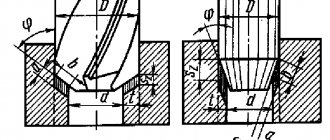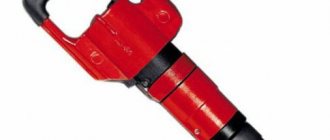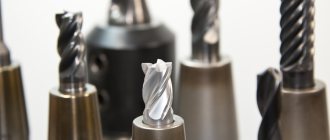Countersink
What is the difference between countersinking and countersinking? Although they sound similar, they are different operations. Each has its own purpose and a specific tool for execution.
What is countersinking? It involves cutting off a larger layer of material in order to create a conical or cylindrical recess in the upper part of the hole, intended for hidden installation of fasteners. Countersinking is also used to select chamfers. A special device for performing this operation is called a countersink. The following types are distinguished:
- cylindrical, used to make cylindrical recesses at the top of the hole to hide the heads of screws or nuts;
- conical, with their help they cut out a cone-shaped recess in the lower part of the hole, chamfer and form recesses for fasteners.
- end, also called counterbore, such a tool is needed for cleaning out recesses before installing fasteners.
Structurally, the countersink consists of two parts: the working head and the shank. A guide pin is provided on the shank, ensuring alignment of the selected recesses.
A drilling machine is usually used as equipment along with countersinks. Less commonly, they are clamped into the chuck of a multi-axis machining center or a simple lathe. Drills and other hand-held drilling tools are not recommended for use as they cannot provide proper alignment and accuracy.
Countersinking is the processing of the inner surface of a hole to improve its quality.
- accuracy;
- roughness;
- forms.
Countersinking is used to process holes made by drilling, stamping or casting. A countersink is used to perform the operation. It resembles a drill, but differs from it in the following ways:
- a large number of cutting edges;
- thickened bridge between edges;
- beveled corner.
These design features determine the stability of the position of the countersink relative to the hole and their coaxiality. The countersink does not deepen the hole, but only improves the smoothness and shape of the surface, removing a very thin layer of material.
Countersinks have from six to eight cutting edges; small diameter tools (up to 20 mm) are made in one piece, while larger ones have inserted blades.
Countersink
Countersink
Metal processing by countersinking is similar to drilling - this is the rotation of a countersink around its axis. When countersinking, the hole is improved to 9-11 accuracy grades. Also, with the help of a countersink, the roughness of the hole is improved to Rz 2.5 microns.
Main purposes of the countersink:
- Calibration of ready-made holes for fasteners (bolts, studs)
- Improving hole quality before tapping or using a reamer.
Countersinking is not done using a conventional drill or any other manual method. After all, the purpose of this operation is aimed at improving the quality of the hole, which is almost impossible to do with a drill. Therefore, countersinking is performed using a machine tool using drilling, turning, and milling machines.
If we divide countersinks into groups, then in metalworking there are two groups according to accuracy:
- Countersink number 1 - Mainly used for semi-finishing as preparatory work before reaming or cutting threads.
- Countersink with number 2 - Used for final work. Has a relatively high accuracy class H11
According to the design, two types of countersinks are used - solid and mounted (disassembled). If we talk about solid ones, they are used more often, and they have a cone-shaped end. It has a groove for chip removal and cooling and cutting teeth. If we talk about mounted countersinks, their design is distinguished by a removable tip, which is attached through an internal hole.
There are also countersinks that are used much less frequently, in special cases. Namely, these are countersinks with welded plates made of the hardest metal, welded or prefabricated countersinks.
The material from which the countersink tip is made
In solid countersinks, P18 or P19 steel is used to make the cutting teeth. If a countersink is made for processing carbide metals, then its teeth are made of metal-ceramic alloys VK4, VK6 or VK8. If steel products are to be processed - T15K6
Types and application of countersinks
Depending on the purpose, countersinks are divided into the following types:
- for making conical or cylindrical recesses inside holes;
- to create reference planes rippled with a hole;
- for chamfering;
- to prepare holes for installation of fasteners.
Based on the shape of the working surface there are:
- cylindrical;
- conical;
- end or straight.
Depending on the diameter, countersinks are divided into:
- regular (0.5 ÷ 1.5 mm);
- with limiter cone (0.5 ÷6 mm);
- with a cone-shaped shank (8÷12 mm).
For the reaming operation, a combined device is used, which includes a drill, a reamer, a countersink and a countersink. They are mounted on a common shank, and the working surfaces are spaced apart in height and come into contact with the metal in turn, as the tool is immersed in the material. The use of such a combined tool allows you to drill a hole, make chamfers, and improve the quality of the surface in one technological pass. This saves a lot of time on changing tools and ensures the accuracy of the dimensions of each structural element. Such a device is expensive and is assembled anew for each hole size, so its use is economically justified only for mass production or for a product with a large number of identical holes of a complex configuration.
Metal countersinking rules
At home, for countersinking recesses (for example, for bolt heads or to change the diameter of a hole to a larger side), a simple drill attached to an electric or even a hand drill is also suitable. On a production scale, countersinking is an operation that requires considerable power and precision of the equipment used. That is why, in production conditions, to perform countersinking, as well as countersinking, the following equipment is used:
- turning (most often);
- drilling (no less often);
- boring (often as one of the secondary operations);
- aggregate (as a secondary operation of an automated line);
- vertical or horizontal milling (rare).
When processing a hole made in a product during its casting, it is advisable to first bore it with a cutter to about 5–10 millimeters in depth so that the countersink takes the correct initial direction.
When processing steel products, it is recommended to use cutting fluids. The process of countersinking cast iron and non-ferrous metals does not require cooling. The correct selection of metal-cutting tools used for both countersinking and countersinking is a very important step
To do this, pay attention to certain factors:
- The type of tool is selected depending on the material of the part and the nature of the processing performed. The location of the hole and the serialization of the processes performed must also be taken into account.
- Based on the specified depth, diameter, and required processing accuracy, the size of the tool for countersinking and countersinking is selected.
- The design of the countersink and countersink is determined by the method of mounting the tool on the machine.
- The material of the tool for performing countersinking or countersinking operations depends on the material of the workpiece (for example, there are countersinks specifically for woodworking), the intensity of the operating mode and some other factors.
Countersinking on a CNC vertical drilling machine
The countersink is selected from reference books or guided by a regulatory document such as GOST 12489-71. The tool must comply with certain technical conditions of use, which is also stipulated by GOST 12489-71.
- Products made of structural steel with holes up to 40 millimeters in diameter are processed with a countersink made of high-speed steel, having a diameter of 10–40 millimeters and 3–4 teeth, respectively.
- For difficult-to-machine products and when boring, equipment with carbide plates with a diameter of 14–50 millimeters and having 3–4 teeth is used.
- In products made of structural steel, holes up to 80 millimeters in diameter are bored with a high-speed steel countersink, using socket heads with a diameter of 32–80 millimeters.
- In products made of non-ferrous metals and cast iron, a feather countersink is used for boring blind holes.
- Blind holes with a diameter of 15–25 millimeters are processed with a special countersinking tool, the body of which has a channel through which the cutting fluid is supplied to the cutting zone.
A necessary condition for countersinking is maintaining allowances. The diameter of the selected tool should ultimately coincide with the final diameter of the hole after processing. When, after countersinking, it is planned to ream the hole, the diameter of the tool is reduced by 0.15–0.3 millimeters. If rough boring or drilling for countersinking is planned, it is necessary to leave an allowance on the side of 0.5 to 2 millimeters.
Design
The conical countersink has two main structural parts:
- a shank designed for attaching a countersink to the chuck of a drilling or lathe;
- a working body for countersinking holes, consisting of 6 ÷ 12 cutting edges of increased thickness (compared to a drill.
The cone sweep angle is from 60 to 120°. The number of edges depends on the diameter of the tool; the larger it is, the more edges there are.
A cylindrical countersink is structurally similar to a drill, but has a larger number of cutting edges. Their length, unlike a drill, is limited by the diameter of the cylinder, since the countersink makes only small recesses in depth.
At the end there is a guide pin that ensures fastening in the chuck. A removable belt can be installed behind the ends of the cutting edges, limiting the depth of immersion into the workpiece. The limiter can be designed as a non-removable part of the countersink. If necessary, a cutting attachment is mounted on the countersink. When depicting a hole in a drawing, the type and size of the countersink is indicated next to it or in an explanatory note in the margin.
For the manufacture of countersinks, high-quality steels are used: tool, high-speed, carbon. The tool is subjected to multi-stage heat treatment, which improves its strength properties.
How to choose the right step drill?
To choose the right step drill, you need to decide on the purposes for which the tool will be used. Thus, it is necessary to determine what size holes need to be drilled
The value of the smallest and largest diameters that are planned to be performed is especially important
You should also decide on what hand tool or machine the drill will be used. The type of shank that should be on the drill depends on this. Therefore, you should carefully study the drill chuck connector and clearly know the shape and dimensions of the shank. If the shank does not fit the existing connectors, you will have to separately purchase a special adapter.
It is important to decide on the manufacturer and level of the tool. As already noted, bright golden-colored stepped conical drills are made with cobalt and titanium impurities, with an abrasive coating and have high hardness
They will last longer and allow you to work with thick rolled products, stainless and alloy steels.
Features of countersinking holes
Countersinking holes is a high-precision operation that requires high-quality tools and proper drilling equipment. Countersinks must undergo periodic inspection to ensure compliance with the standard for diameter and taper angle. The test results are recorded in the instrumental section log.
Metalworking specialists have formulated the following recommendations for performing the operation:
- when working with hard steel or cast iron alloys, special emulsions, for example, coolant liquid, should be used to cool the material and tool;
- when selecting a tool, you need to take into account the material of the part, its strength and hardness;
- Before starting work, you should check the reliability and accuracy of fixation of the tool in the chuck and the absence of any special spindle runout;
- to countersink an internal chamfer, you should use a special mandrel that centers the tool;
The countersunk hole should be checked for compliance with the dimensions of the drawing only with a verified measuring tool.
Centering drills: what are they, their characteristics
Anyone who has ever drilled holes knows how important it is to ensure that the holes are straight and made exactly where they need to be. After all, usually, if the hole is uneven, made at an angle or slightly in the wrong place, the part or material has to be thrown away
That's why they came up with a special tool called centering drills.
Let's figure out what this tool is. Metal centering drills (or, as they are also called, centering drills) are special multifunctional (they have several work areas to perform different operations) tools for cutting metal.
Appearance of a center drill
They are usually quite short, have a thin working cutting area, tapered cutting edges and a thicker tail (a couple of times thicker than the working part), which provides improved tool rigidity.
Current GOST
Currently, state standard 14953-80 continues to apply. It regulates the technical conditions for countersinking, standard dimensions of the tool, and the material for its manufacture. The standard also describes the operating modes of the equipment depending on the mechanical characteristics of the material being processed.
Download GOST 14953-80
Tables for selecting standard countersinks serve as an aid for designers and technologists in determining design parameters and developing technical processes.











